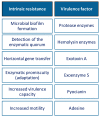Microbial Resistance to Antibiotics and Effective Antibiotherapy
- PMID: 35625857
- PMCID: PMC9138529
- DOI: 10.3390/biomedicines10051121
Microbial Resistance to Antibiotics and Effective Antibiotherapy
Abstract
Currently, the efficacy of antibiotics is severely affected by the emergence of the antimicrobial resistance phenomenon, leading to increased morbidity and mortality worldwide. Multidrug-resistant pathogens are found not only in hospital settings, but also in the community, and are considered one of the biggest public health concerns. The main mechanisms by which bacteria develop resistance to antibiotics include changes in the drug target, prevention of entering the cell, elimination through efflux pumps or inactivation of drugs. A better understanding and prediction of resistance patterns of a pathogen will lead to a better selection of active antibiotics for the treatment of multidrug-resistant infections.
Keywords: antibiotherapy; antibiotic resistance; biofilms; mechanism of resistance; multidrug-resistant bacteria; persistence.
Conflict of interest statement
The authors declare no conflict of interest.
Figures










References
-
- Georgescu M., Ginghină O., Raita S., Tăpăloagă D., Ilie L., Negrei C., Popa D.E., Varlas V., Multescu R., Rosca A.C., et al. Natural alternative remedies in the background of updated recommendations for the prophylactic and therapeutic approach of clostridium difficile infections. Farmacia. 2018;66:4. doi: 10.31925/farmacia.2018.4.1. - DOI
Publication types
LinkOut - more resources
Full Text Sources

